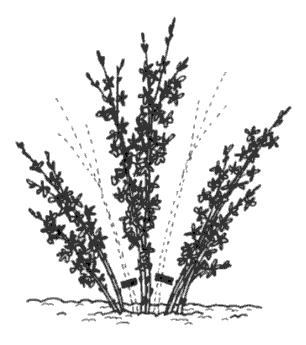Watering
Newly planted forsythias need plenty of water while they are getting established. After that, if they are planted in good soil--soil that is rich in organic matter so it holds moisture and drains well--forsythias can manage fine with normal rainfall, especially if they are mulched. They will need supplemental watering only in time of drought and in late fall before the ground freezes for the winter. If they are planted in poor, thin soil, and are not mulched, their soil will dry out rapidly in the summer heat and they will need watering. During periods of heat and scarce rainfall, soak the soil over their root zone every 10 days to 2 weeks with a sprinkler or drip system.
For more information see file on Choosing Watering Equipment.
Fertilizing
After a newly planted forsythia has been in place for about a year, fertilize it with an all-purpose, slow-acting granular fertilizer. In the fall sprinkle a cupful or so on the soil beneath the forsythia out to 1-1/2 feet beyond the tips of its branches (dripline) for the rain to soak in. If it is planted in good soil, it will not need regular annual fertilizing after the first year or two. If it is mulched, the decomposing mulch layer will provide some nutrition and organic matter to the soil. Do not overdo fertilizer; forsythias do not need much encouragement to grow.
For more information see file on Choosing Fertilizer.
Mulching
A layer of organic mulch spread over the soil under the forsythia shrub year round will keep the soil moist and discourage weeds. Spread a 2 to 4 inch layer of chopped leaves, wood chips or shredded bark product from the garden center out to the its dripline. This will add valuable organic matter to the soil as it decomposes over time. It will also harbor beneficial organisms to help control pest insect populations in your yard. Keep the mulch about 6 inches away from the stems at the base of the forsythia to avoid stem rot and possible rodent damage. Do not mulch with whole leaves because they mat together, preventing water from soaking into the soil.
For more information see file on Using Mulch In The Yard.
Pruning/Grooming
 |
Prune back the stems of forsythias that are getting too big shortly after spring bloom. They begin to grow flower buds during the summer, so if you wait until later in the summer to prune you will cut the buds off and have no flowers next spring. Prune out broken branches any time. Clip off overlong or misshapen branches individually with sharp pruners to achieve a controlled, but natural shape. Forsythias do not respond well to formal hedge shearing. If you have a weeping type of forsythia allow the branches to grow long and droop, as this is the shrub’s natural habit.
To renovate forsythia shrubs that are overgrown through neglect, prune them severely in the spring. With loppers or pruning saw cut all stems back to within 6 inches of the ground to stimulate vigorous new growth from the base of the shrub. The shrub will recover fully in 2 to 3 years. An alternative to this major surgery is to use the one-third rule. Cut back only one-third of the stems--the oldest, thickest and deadest-looking canes--to ground level. Do this every two or three years until all old wood is gone and has been replaced by young, new growth. If too many thin new stems develop, remove most of them, leaving a strategic few to replace removed stems.
For more information see files on Pruning Shrubs and Choosing Pruning Tools
Winter Protection
A really cold winter may cause some damage to forsythias, but they usually recover easily. Protect shrubs in exposed locations from winter wind with a screen of burlap or some other material that allows air to circulate around the shrub. Where heavy snow and ice are common, tie branches loosely together or build wooden A-frame shelters over the shrubs. A 3 or 4-inch winter mulch will insulate the soil against extreme fluctuations of temperature that cause it to heave and disturb shrub roots. If you have chronic rodent problems, wait until the ground freezes to spread the mulch, so they will have to look elsewhere to nest.
For more information see file on Winter Protection For Plants and Plant Protection Supplies.
Propagating Forsythia
It is easy to get more forsythia shrubs from the one you have. They often “layer” or root themselves to form subsidiary plants. Drooping stems that come in contact with the soil will produce roots at that spot. Carefully clip off the branch so that the rooted piece is independent of the parent plant and gently dig it from the soil or mulch where it is rooted. Transplant it to a place where you want to have another forsythia. Sometimes tender forsythia stems will generate roots if you set them in a bucket of water for a while.

